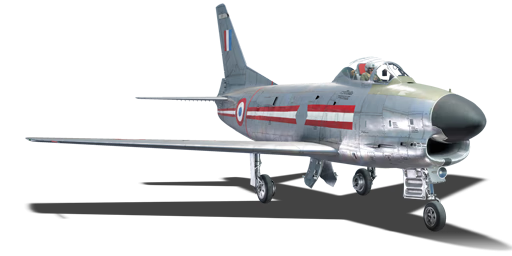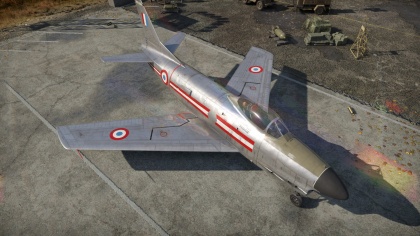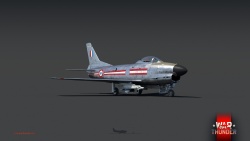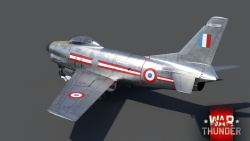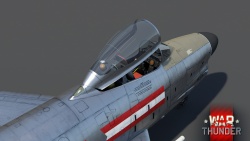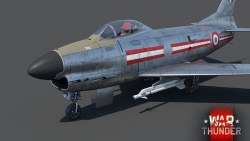Difference between revisions of "F-86K (France)"
(Reverted edit by User:CDT_GALAAD. Translation-plagiarism from http://avions-de-la-guerre-d-algerie.over-blog.com/article-les-north-american-f-86-k-sabre-francais-122102940.html) |
(→General info) |
||
| Line 42: | Line 42: | ||
|- | |- | ||
|} | |} | ||
| + | |||
==== Details ==== | ==== Details ==== | ||
| Line 78: | Line 79: | ||
|- | |- | ||
|} | |} | ||
| + | |||
==== Engine performance ==== | ==== Engine performance ==== | ||
| Line 111: | Line 113: | ||
| ''Optimal'' || 2,294 kgf<br />(0 km/h) || 4,467 kgf<br />(0 km/h) | | ''Optimal'' || 2,294 kgf<br />(0 km/h) || 4,467 kgf<br />(0 km/h) | ||
| 0.64 || 0.62 || 0.59 || 0.54 || 0.47 | | 0.64 || 0.62 || 0.59 || 0.54 || 0.47 | ||
| + | |- | ||
| + | |} | ||
| + | |||
| + | === Manual Engine Control === | ||
| + | {| class="wikitable" style="text-align:center" | ||
| + | |- | ||
| + | ! colspan="7" | MEC elements | ||
| + | |- | ||
| + | ! rowspan="2" | Mixer | ||
| + | ! rowspan="2" | Pitch | ||
| + | ! colspan="3" | Radiator | ||
| + | ! rowspan="2" | Supercharger | ||
| + | ! rowspan="2" | Turbocharger | ||
| + | |- | ||
| + | ! Oil | ||
| + | ! Water | ||
| + | ! Type | ||
| + | |- | ||
| + | | Not controllable || rowspan="2" | Not controllable<br>Not auto controlled || rowspan="2" | Not controllable<br>Not auto controlled || rowspan="2" | Not controllable<br>Not auto controlled || rowspan="2" | Separate || rowspan="2" | Not controllable<br>1 gear || rowspan="2" | Not controllable | ||
|- | |- | ||
|} | |} | ||
=== Survivability and armour === | === Survivability and armour === | ||
| − | + | <!--Examine the survivability of the aircraft. Note how vulnerable the structure is and how secure the pilot is, whether the fuel tanks are armoured, etc. Describe the armour, if there is any, and also mention the vulnerability of other critical aircraft systems.--> | |
| + | The plane is equipped at the front with a 6.35 mm steel plate protecting the pilot's wrist and up. The cockpit's frontal glass is made of 38mm of bulletproof glass that helps against incoming small caliber rounds. All the while the pilot's seat is made of 12.7mm of steel which protects his back of any incoming small caliber rounds and shrapnel. | ||
| + | |||
| + | ===Radars=== | ||
| + | {{main|AN/APS-21}} | ||
| + | The F-86K is equipped with an [[AN/APS-21]] search radar, located in the nose of the aircraft. | ||
| + | |||
| + | {| class="wikitable" style="text-align:center" | ||
| + | ! colspan="4" | [[AN/APS-21]] - Target Detection Radar | ||
| + | |- | ||
| + | ! {{Annotation|Maximum<br/>Detection<br/>Range|The maximum possible range at which a target can be detected}} | ||
| + | ! {{Annotation|Guaranteed<br/>Detection<br/>Range|The range, below which, detection of a target is practically guaranteed}} | ||
| + | ! {{Annotation|Max Azimuth<br/>Scan Angle|How far to each side the radar can scan (widest search mode)}} | ||
| + | ! {{Annotation|Max Elevation<br/>Scan Angle|How far up and down the radar can scan (widest search mode)}} | ||
| + | |- | ||
| + | | 45,000 m || 28,000 m || ±85° || ±16° | ||
| + | |- | ||
| + | |} | ||
== Armaments == | == Armaments == | ||
Revision as of 14:14, 28 May 2020
Contents
| This page is about the French jet fighter F-86K (France). For other versions, see F-86 (Family). |
Description
The ▄F-86K Sabre is a rank VI French jet fighter
with a battle rating of 9.0 (AB/RB) and 9.3 (SB). It was introduced in Update 1.89 "Imperial Navy".
The original F-86D was developed as bomber interceptor and was outfitted with a retractable ventral rocket-rack which housed 24 x 2.75 in (70 mm) Mighty Mouse folding-fin aerial rockets. Lacking cannons or air-to-air missiles, the F-86D was limited in role strictly as a bomber hunter. In 1953 the Italians approached North American in an attempt to modify the existing F-86D into a fighter-interceptor, however, the proposed changes proved too costly. This cost overage required scaling back the requirements and from this was produced the F-86K, a fighter-interceptor aircraft which was outfitted with 4 x 20 mm cannons and two AIM-9B Sidewinder missiles. Originally this aircraft was produced for the U.S., however, later the Italian manufacturer Fiat was licensed to also manufacture and produce this version of the fighter.
|
Fun Fact: The Sabre Dog was initially to be designated F-95, but had its name changed to F-86D instead, in order to make it seem like a variant of the existing Sabre and not an entirely new aircraft. In reality, however, the F-86D was only about 25% similar to the original F-86 and the name change was only done to secure further support for the project.
|
General info
Flight performance
The F-86K is a good aircraft at its rank, but not the best. The F-86K has very good low-end acceleration due to its afterburner, however, this aircraft is still only a subsonic fighter. Like every other jet, it's bad at manoeuvring at low speeds and it's control surfaces compress at high speeds. However, the F-86K can handle top speed relatively well compared to other aircraft of its rank. If the F-86K can do one thing very well, it excels when going into vertical flight.
| Characteristics | Max Speed (km/h at 0 m - at sea level) |
Max altitude (metres) |
Turn time (seconds) |
Rate of climb (metres/second) |
Take-off run (metres) | |||
|---|---|---|---|---|---|---|---|---|
| AB | RB | AB | RB | AB | RB | |||
| Stock | 1,103 | 1,097 | 15500 | 27.4 | 28.3 | 42.7 | 37.1 | 1,000 |
| Upgraded | ??? | 1,111 | ??.? | 27.0 | ??.? | 56.0 | ||
Details
| Features | |||||
|---|---|---|---|---|---|
| Combat flaps | Take-off flaps | Landing flaps | Air brakes | Arrestor gear | Drogue chute |
| ✓ | ✓ | ✓ | ✓ | X | ✓ |
| Limits | ||||||
|---|---|---|---|---|---|---|
| Wings (km/h) | Gear (km/h) | Flaps (km/h) | Max Static G | |||
| Combat | Take-off | Landing | + | - | ||
| 0 | 350 | 620 | 620 | 370 | ~8 | ~4 |
| Optimal velocities (km/h) | |||
|---|---|---|---|
| Ailerons | Rudder | Elevators | Radiator |
| < 850 | < 600 | < 660 | N/A |
Engine performance
| Engine | Aircraft mass | ||||||
|---|---|---|---|---|---|---|---|
| Engine name | Number | Empty mass | Wing loading (full fuel) | ||||
| General Electric J47-GE-17B | 1 | 6,430 kg | 292 kg/m2 | ||||
| Engine characteristics | Mass with fuel (no weapons load) | Max Takeoff Weight | |||||
| Weight (each) | Type | 13m fuel | 20m fuel | 30m fuel | 46m fuel | ||
| 1,150 kg | Afterburning axial-flow turbojet | 6,952 kg | 7,227 kg | 7,620 kg | 8,248 kg | 9,530 kg | |
| Maximum engine thrust @ 0 m (RB / SB) | Thrust to weight ratio @ 0 m (100%) | ||||||
| Condition | 100% | WEP | 13m fuel | 20m fuel | 30m fuel | 46m fuel | MTOW |
| Stationary | 2,294 kgf | 4,467 kgf | 0.64 | 0.62 | 0.59 | 0.54 | 0.47 |
| Optimal | 2,294 kgf (0 km/h) |
4,467 kgf (0 km/h) |
0.64 | 0.62 | 0.59 | 0.54 | 0.47 |
Manual Engine Control
| MEC elements | ||||||
|---|---|---|---|---|---|---|
| Mixer | Pitch | Radiator | Supercharger | Turbocharger | ||
| Oil | Water | Type | ||||
| Not controllable | Not controllable Not auto controlled |
Not controllable Not auto controlled |
Not controllable Not auto controlled |
Separate | Not controllable 1 gear |
Not controllable |
Survivability and armour
The plane is equipped at the front with a 6.35 mm steel plate protecting the pilot's wrist and up. The cockpit's frontal glass is made of 38mm of bulletproof glass that helps against incoming small caliber rounds. All the while the pilot's seat is made of 12.7mm of steel which protects his back of any incoming small caliber rounds and shrapnel.
Radars
The F-86K is equipped with an AN/APS-21 search radar, located in the nose of the aircraft.
| AN/APS-21 - Target Detection Radar | |||
|---|---|---|---|
| Maximum Detection Range |
Guaranteed Detection Range |
Max Azimuth Scan Angle |
Max Elevation Scan Angle |
| 45,000 m | 28,000 m | ±85° | ±16° |
Armaments
Offensive armament
The F-86K (France) is armed with:
- 4 x 20 mm M24A1 cannons, nose-mounted (132 rpg = 528 total)
Suspended armament
The F-86K (France) can be outfitted with the following ordnance:
- Without load
- 2 x AIM-9B missiles
Usage in battles
Describe the tactics of playing in an aircraft, the features of using aircraft in a team and advice on tactics. Refrain from creating a "guide" - do not impose a single point of view, but instead, give the reader food for thought. Examine the most dangerous enemies and give recommendations on fighting them. If necessary, note the specifics of the game in different modes (AB, RB, SB).
Radars
The F-86K is equipped with an AN/APS-21 search radar, located in the nose of the aircraft.
| AN/APS-21 - Target Detection Radar | |||
|---|---|---|---|
| Maximum Detection Range |
Guaranteed Detection Range |
Max Azimuth Scan Angle |
Max Elevation Scan Angle |
| 45,000 m | 28,000 m | ±85° | ±16° |
Manual Engine Control
| MEC elements | ||||||
|---|---|---|---|---|---|---|
| Mixer | Pitch | Radiator | Supercharger | Turbocharger | ||
| Oil | Water | Type | ||||
| Not controllable | Not controllable Not auto controlled |
Not controllable Not auto controlled |
Not controllable Not auto controlled |
Separate | Not controllable 1 gear |
Not controllable |
Modules
| Tier | Flight performance | Survivability | Weaponry | ||
|---|---|---|---|---|---|
| I | Fuselage repair | Offensive 20 mm | |||
| II | New boosters | Compressor | Airframe | AIM-9B | |
| III | Wings repair | Engine | New 20 mm cannons | ||
| IV | G-suit | Cover | |||
Pros and cons
Pros:
- Possesses payload of two air-to-air missiles AIM-9B Sidewinders
- Good roll rate at low/medium speed (<800 kph)
- High velocity 20 mm cannons, highly effective in head-ons and deflection shots
- Good acceleration with afterburner
- Brake chute
- Has a search radar (can only spot bombers or large attackers)
Cons:
- Subsonic
- Heavy compared to regular Sabres so less nimble, even with leading slats
- Hard compression at high speed (>900 kph), especially in the roll axis
- Can easily rip wings with strong input
- No bombs or rockets
- Afterburner guzzles a lot of fuel
History
In March 1949, the North American company launched the development of a new jet interceptor, based on the existing F-86 Sabre, as part of a private venture. The new design was the first interceptor developed to be operated by a single crew member and utilized unguided rockets in combination with a complex fire control system, rather than conventional guns, in order to destroy its target. Already by April, the project had received official endorsement from high-ranking military officials and development of a production version began in parallel.
While a production contract was signed in October, the first prototype, designated YF-95, conducted its maiden flight in December 1949. In the early ‘50s, Soviet nuclear testing and the subsequent start of the Korean conflict led to an accelerated development of the YF-95. Despite this, problems during development caused production to be delayed, resulting in the aircraft reaching its first units only in March 1951. During the delay however, the designation of the aircraft changed to F-86D and it received its unofficial nickname “Sabre Dog”.
In January 1953, North American was approached by an offer from the Italian military to develop a twin-seater version of the F-86D armed with cannons. As the cost and necessary redesign work turned out to be too great, an agreement was made to produce the aircraft in its original design, but with cannon armament and a simplified fire control system instead. This new export version of the Sabre Dog received the new designation of F-86K.
Initially, the F-86K was produced exclusively in the U.S., but would later also be manufactured under licence by the Italian Fiat company. The F-86 entered service in 1955 and apart from the Italian Air Force, the F-86K also served with many other operators worldwide including France, West Germany, the Netherlands, Norway, Honduras, Venezuela. Around 340 F-86Ks were produced out of over 2,800 Sabre Dogs built in total. Most of the F-86Ks would be decommissioned by the late ‘60s, while some even went on to serve into the ‘70s.
- From Devblog
Media
- Images
- Videos
See also
- Related development
- Canadair Sabre (those Sabres manufactured with the designator "CL")
- North American F-86A/F
- North American F-100 Super Sabre
- North American FJ-4 Fury
- Aircraft of comparable role, configuration and era
- Dassault Super Mystère
- Grumman F-9 Cougar
- Hawker Hunter
- Lavochkin La-15
- Mikoyan-Gurevich MiG-15
- Mikoyan-Gurevich MiG-17
- Saab J29 Tunnan
External links
| North American Aviation | |
|---|---|
| Fighters | |
| P-51A | P-51 · P-51A |
| P-51C | P-51C-10 |
| P-51D | P-51D-5 · P-51D-10 · P-51D-20-NA · P-51D-30 |
| P-51H | P-51H-5-NA |
| Twin-engine fighters | F-82E |
| Jet fighters | F-86A-5 · F-86F-2 · F-86F-25 · F-86F-35 · F-100D |
| Strike aircraft | A-36 · PBJ-1H · PBJ-1J |
| FJ-4B · FJ-4B VMF-232 | |
| Bombers | B-25J-1 · B-25J-20 |
| Export/Licence | ▂B-25J-30 · ␗B-25J-30 |
| ▄Mustang Mk IA · F-6C-10-NA · ␗P-51C-11-NT · ␗P-51D-20 · J26 David · J26 · P-51D-20-NA · ␗P-51K | |
| F-86F-30 ▅ · ␗F-86F-30 · F-86F-40 ▅ · F-86F-40 JASDF▅ · ␗F-86F-40 | |
| ◄F-86K · ▄F-86K (Italy) · ▄F-86K (France) | |
| ␗F-100A · ▄F-100D · ␗F-100F | |
| Captured | ▅P-51C-11-NT |
| Canadair Limited license-built the F-86 as the CL-13 for use in Canada and export to Europe. | |
| Fiat license-built the F-86K for the Italian Air Force though another 120 NAA built F-86Ks were also sold to the Italians. | |
| See Also | Mitsubishi Heavy Industries · Canadair Limited · Fiat Aviation |
| France jet aircraft | |
|---|---|
| Fighters | M.D.450B Ouragan · M.D.450B Barougan · M.D.452 IIA · M.D.452 IIC · Mystere IVA · Super Mystere B2 |
| ▄F-86K · ▄F-100D · ▄F-8E(FN) | |
| Mirage IIIC · Mirage IIIE · Milan · Mirage 5F · Mirage 2000C-S4 · Mirage 2000C-S5 · Mirage 2000-5F · Mirage 4000 | |
| Mirage F1C · Mirage F1C-200 · Mirage F1CT | |
| Strike aircraft | ▄F-84F · F-84F IAF · ▄F-84G-26-RE |
| Etendard IVM · Super Etendard · Alpha Jet E | |
| Jaguar A · Jaguar E · Mirage 2000D-R1 · Mirage 2000D-RMV | |
| Bombers | S.O.4050 Vautour IIA · Vautour IIA IDF/AF · S.O.4050 Vautour IIB · S.O.4050 Vautour IIN · S.O.4050 Vautour IIN (late) |
| Belgium | ▄Meteor F Mk.8 · ▄Mirage 5BA · ▄F-104G · ▄F-16A · ▄F-16AM |
| Netherlands | ◘Sea Hawk Mk.50 · ◘Hunter F.6 |


